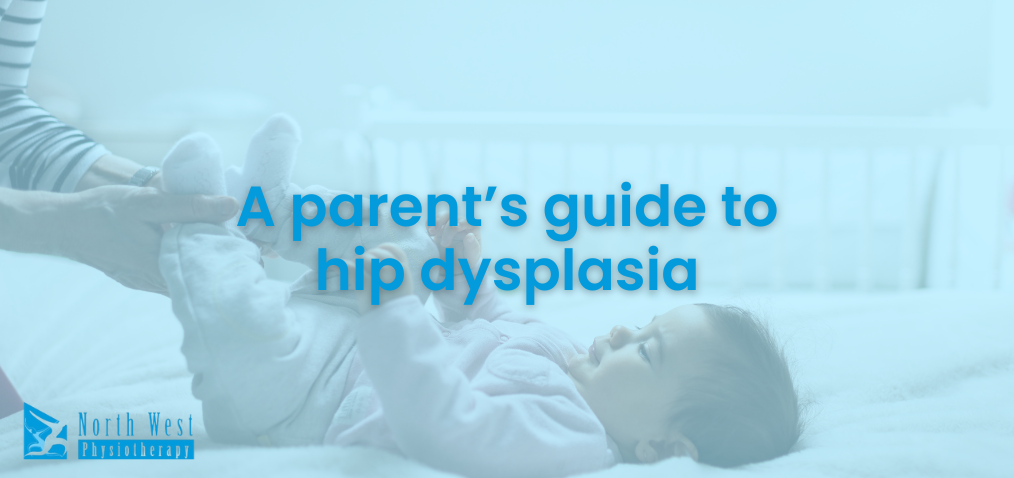When your child is diagnosed with hip dysplasia, it can feel like you’ve stepped into a world of medical jargon and unanswered questions. You may be wondering, “What does this mean for my child’s future?”. At North West Physio Lutwyche, we’re here to help you navigate this journey with expert care and a compassionate approach.
Hip dysplasia is more common than you might think, especially in babies and young children. The good news? It’s a highly manageable condition with early detection and the right support. Our specialised paediatric team is dedicated to helping your child thrive, no matter where they’re starting from.
What is hip dysplasia?
Hip dysplasia is a condition where the hip joint doesn’t form correctly. The curved part of the pelvis (the socket) is too shallow, meaning the thigh bone (femur) doesn’t sit securely in place. Differences in the hip socket and femur size, shape, or organisation can cause this misalignment.
It’s most common in babies and young children, though in rare cases, it can show up later in life. Early diagnosis and treatment are key to avoiding long-term issues.
Hip dysplasia in newborn: how to spot it
The symptoms of hip dysplasia can vary depending on your child’s age.
In babies, you might notice:
- A clicking or popping sound when their hip is moved
- Uneven skin folds near the buttocks
- Legs that are difficult to spread apart
- Differences in leg length
- Leaning their weight to one side when sitting
These small signs might not seem urgent initially, but they’re worth checking.
Hip dysplasia in childhood can present as:
In children aged 3-5, you might notice delays in sitting, standing or walking milestones, and limping or walking unevenly
For adolescents and adults, symptoms often appear as sharp groin pain, especially during activities like walking, climbing stairs, or running.
Hip dysplasia causes
The exact cause of hip dysplasia isn’t fully understood, but certain factors can increase the likelihood such as:
- Being a firstborn child
- Female gender
- A breech birth
- A family history of hip dysplasia
- Hormonal changes in the mother
- Baby’s position in the womb
How is hip dysplasia diagnosed?
In Australia, all newborns are screened for hip dysplasia in their first few days of life and again at six weeks. If a potential issue is detected, an ultrasound is often used to confirm the diagnosis.
For older children and adults, a physical exam, X-ray, and sometimes an MRI or CT scan are used to assess the hip joint in more detail.
Hip dysplasia treatment options
The good news is that hip dysplasia is treatable, especially when diagnosed early.
Babies and young children may be fitted with a Pavlik harness, a soft brace that helps guide the hips into proper alignment. In some cases, surgery followed by the use of a Rhino brace may be required.
Treatment focuses on managing pain and maintaining joint health for adolescents and adults. This can include physiotherapy, strengthening exercises, and avoiding high-impact activities. In severe cases, surgery may be required to reshape the pelvis or repair damaged cartilage.
How can a hip dysplasia physio aid in recovery?
At North West Physio Lutwyche, we know every child is different. Whether it’s helping a baby in a harness or guiding an older child through exercises, our paediatric physiotherapists approach treatment with patience and care.
Many parents come to us after noticing their baby isn’t meeting certain milestones, like bearing weight evenly on both legs or having trouble spreading their hips during nappy changes. With early assessment and a personalised treatment plan, we’ve seen countless children go on to sit, crawl, and walk with confidence. Early intervention does make all the difference.
Hip dysplasia support: what to do if you’re concerned
If you’ve noticed any of these signs or have concerns about your child’s development, the next step is to book an appointment with our North West Physio Lutwyche team. Early detection really does make all the difference.
We’ll take the time to understand your concerns, assess your child’s hips, and guide you through the next steps with care and expertise.
A parent’s guide to hip dysplasia
If your child has been diagnosed with hip dysplasia or you’re concerned about their development, don’t wait to seek support. Book an appointment with North West Physio Lutwyche today. Together, we’ll create a plan to help your child thrive.
By Dan & Vince






